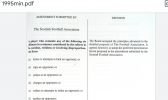Yeh, I know the definitions.
Recklessness is not about injury, but about consequences. We assume injury is the most relevant consequence, but it is not written. The most important bit is the state of mind of the offender - that he was reckless as to the consequence we have in mind.
When we think about lack of attention or precaution, we have to also be thinking about what we want to offender to be avoiding.
Simply wanting them to avoid kicking is not right, otherwise they also wouldn't be allowed to tackle or challenge or push or charge etc. I daresay we all have in mind that we want the offender to be careful as to avoiding some particular unfairness to their opponent, such as pain or unfairly losing their position on the field or being unfairly prevented from playing the ball
You are correct that the offender's state of mind is relevant but you are mistaken in the way you have equated kicking an opponent with challenging an opponent. This is because kicking an opponent is
usually unintentional and challenging an opponent is
usually intentional.
The way I see it is that there are two ways in which a player can be "careless".
The first is inadvertence. This is when a player does something without intending to do it. For example, a player attempts to kick the ball but instead unintentionally kicks an opponent; the player has kicked an opponent 'carelessly'. A real life example would be a person who accidentally drops their phone on the floor; they are careless.
The second way is when a player does something intentionally but the way they do it is careless. For example, a player intentionally challenges an opponent for the ball but uses too much force in making that challenge. If the force used "shows a lack of attention or consideration", the player is by definition careless. A real life example would be a person who intentionally throws their phone onto a sofa but throws with too much force damaging the screen; they are careless.
This is the most subjective part of the laws and the referee's opinion is key. Indeed, law 12 states explicitly that these types of offences are only committed if they are done "in a manner
considered by the referee to be careless, reckless..." (emphasis added). Opinions will differ between referees.
Anyway, the analysis I've just done of Law 12 is completely pointless because we referees know how to apply the laws in accordance with what football expects. We make decisions about 'carelessness' naturally without even considering the exact wording of the law. We know what it means instinctively from years of playing, refereeing and watching football.



